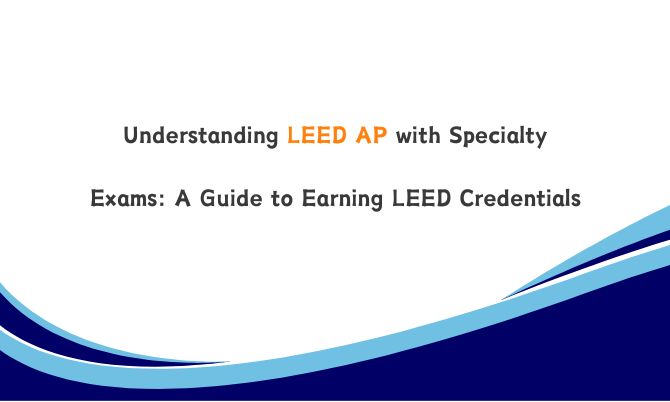The construction industry's shift towards sustainability has created high demand for green building experts. The Leadership in Energy and Environmental Design (LEED) certification, developed by the U.S. Green Building Council (USGBC), stands as the leading standard for evaluating building environmental performance. To support this initiative, professionals can earn the LEED Accredited Professional (LEED AP) with Specialty credential, demonstrating their expertise in guiding sustainable building projects through certification.

A LEED AP with Specialty credential holder is an individual who has demonstrated the knowledge, skills, and abilities required to assist in the LEED certification process. LEED APs with Specialty are experts in specific areas of green building, and their expertise is critical in guiding projects through the certification process, from planning and design to construction and maintenance.
There are several specialties within the LEED AP category, including:
LEED AP BD+C (Building Design and Construction)
LEED AP Homes
LEED AP ID+C (Interior Design and Construction)
LEED AP ND (Neighborhood Development)
LEED AP O+M (Operations and Maintenance)
Each specialty focuses on different aspects of the built environment, and LEED APs with these credentials are equipped to address the unique challenges and requirements of each area.
To earn a LEED AP with Specialty credential, candidates must pass a rigorous exam. Each LEED AP exam contains 100 multiple-choice questions and is delivered via computer. The total duration of the exam is 2 hours, and a score of 170 or higher out of a possible 200 points is required to pass.
The exams are based on the LEED v4 rating system, and candidates taking the exam in 2024 and 2025 will be tested on content from this version of the rating system. The LEED v4 system focuses on strategies for energy and water efficiency, material selection, indoor environmental quality, and other sustainable building practices.
The exam questions are drawn from a comprehensive job task analysis conducted by the Green Building Certification Institute (GBCI) and a global network of Subject Matter Experts (SMEs). This analysis ensures that the exam content is relevant, reliable, and reflective of the skills and knowledge needed to effectively support LEED projects.
LEED AP exams are available in multiple languages, depending on the specialty:
LEED AP BD+C: Available in English, Arabic, Brazilian Portuguese, Chinese, French, and Spanish
LEED AP Homes: Available in English
LEED AP ID+C: Available in English
LEED AP ND: Available in English
LEED AP O+M: Available in English, Arabic, Brazilian Portuguese, Chinese, French, and Spanish
This global accessibility helps ensure that professionals around the world can pursue their LEED credentials, regardless of their native language.
The LEED AP exams are updated regularly to ensure their relevance and alignment with current industry standards. Each year, the exam questions are reviewed and maintained through a rigorous process that includes the following:
Performance Evaluation: Questions are assessed based on their performance in previous exams. Any questions that perform poorly are removed and replaced with new ones.
LEED Addenda: The exams are also updated to incorporate any new LEED addenda (amendments or updates to the LEED standards) published through January of the same year. This ensures that exam content remains aligned with the most current sustainable building practices.
This continuous process of evaluation and update ensures that the LEED AP exams remain a valid and reliable tool for assessing a candidate's expertise in green building.
Success on the LEED AP with Specialty exam requires a combination of knowledge, experience, and strategic preparation. Here are some steps to help you prepare:
Familiarize Yourself with the LEED v4 Rating System: The exam content is primarily based on the LEED v4 system, so it's essential to study the rating system and understand the key concepts related to sustainability, energy efficiency, water conservation, and other areas covered by LEED.
Use Official Study Materials: GBCI offers a variety of study materials, including the LEED AP Reference Guide, which provides a comprehensive overview of the exam content. You can also take practice exams to familiarize yourself with the question format and timing.
Attend a LEED Exam Prep Course: Many training providers offer LEED AP exam prep courses. These courses are designed to help you understand the exam structure, review key concepts, and improve your test-taking skills.
Join a Study Group: Collaborating with others who are also preparing for the exam can be an effective way to stay motivated and share resources and tips.
Take Practice Exams: LEED AP practice exams are a valuable tool for testing your knowledge and identifying areas where you may need additional study.
Stay Updated on LEED Changes: Since the LEED standards are regularly updated, it's important to stay informed about any changes or new developments in the rating system, especially those related to your specialty.
Earning a LEED AP with Specialty credential is a significant achievement that demonstrates your expertise in sustainable building practices. Whether you are pursuing the BD+C, Homes, ID+C, ND, or O+M specialty, the LEED AP exam is a comprehensive test of your knowledge and skills in the field of green building.
By understanding the exam structure, familiarizing yourself with the LEED v4 rating system, and utilizing effective study strategies, you can increase your chances of success and earn your LEED AP credential. With continued professional development and an eye on industry changes, you will be well-equipped to make a positive impact on the environment through your work in sustainable building and design.